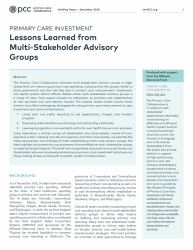
Using interviews, a written survey of stakeholders and state leaders, review of laws, executive orders, meeting minutes and agendas, and short case studies, we describe the roles, composition, and activities of multi-stakeholder primary care advisory groups. We then highlight characteristics and processes of more effective multi-stakeholder groups as reported by participants. This brief aims to generate discussion and assist states and stakeholders who are considering embarking on primary care investment initiatives and those making strides on the path to health-system transformation.
The report shows that the U.S. health system’s investment in primary care, as measured by primary care spending, is low and declined between 2017 and 2019, both in a majority of states and nationally. The findings support a growing body of literature showing that health systems with a foundation of robust, comprehensive primary care achieve better, more equitable health outcomes and are less costly.
| Attachment | Size |
|---|---|
| 567.98 KB |

